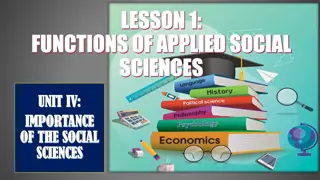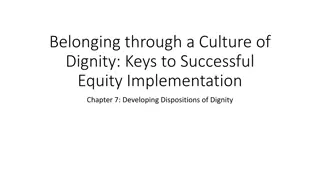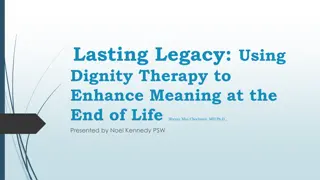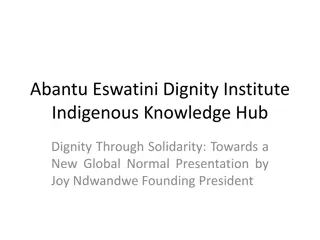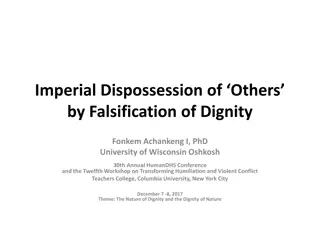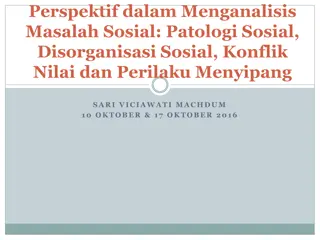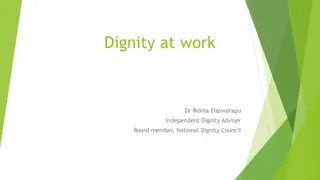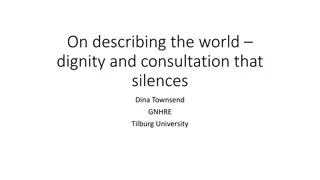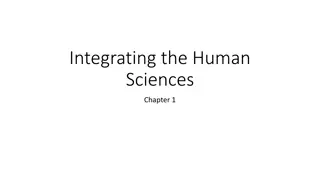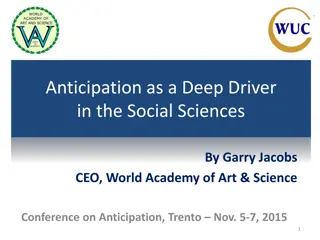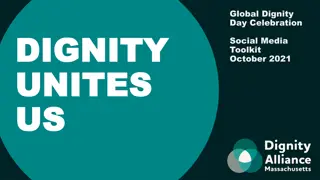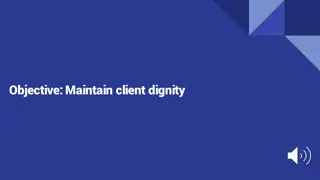Exploring Perspectives on Dignity in Social Sciences
Perspectives on dignity in social science research are multifaceted and complex, with ongoing debates on its definition and application in various contexts. The images and discussions presented delve into different views of dignity, its challenges in definition, and the importance of understanding and respecting dignity in healthcare and social care settings.
Download Presentation

Please find below an Image/Link to download the presentation.
The content on the website is provided AS IS for your information and personal use only. It may not be sold, licensed, or shared on other websites without obtaining consent from the author. Download presentation by click this link. If you encounter any issues during the download, it is possible that the publisher has removed the file from their server.
E N D
Presentation Transcript
Three views of dignity Social Science in the City 19 April 2012
How I got here Teaching Conference Awareness of many and varied occasions of use Obama on Syria and the Arab spring Dignity of the care worker Dignity of the bereaved or assaulted Dominique Strauss Kahn Kim Jong-un
Appeals to dignity in health and social care 2006: 2009: Feb 2010: Francis Report: Mid-Staffs Hosp Feb 2011: Health Service Ombudsman: Care and Compassion Report Oct 2011: CQC: Dignity and nutrition for older people Nov 2011:Francis enquiry re-opened. Nov 2011:EHRC: Inquiry into Home Care Feb 2012: Cmn on Dignity in Care: Delivering Dignity Dignity in Care Campaign National Dignity Council Winterbourne View?
Defining dignity ...dignity itself has proved very difficult to define. For more than a decade, researchers have struggled to pin down what is in essence an ethical concept that varies according to the cultural, historical and philosophical contexts in which it is discussed some have taken the view that difficulties of definition made an emphasis on dignity in care, at best, of limited use in practice (SCIE 2010)
Aims To set out some ideas about how the concept can be understood - particularly through how it is used To consider its strengths and limitations in thinking about how failures and abuses in practice can be addressed
Three views of dignity Of all - as something shared equally by human beings as such Of each - as something associated with a particular status or rank Of a community - as something which marks out how we think of ourselves collectively
The dignity of all In the West we are much more likely to acknowledge concern with the dignity of all, than the dignity of each Written into the Universal Declaration of Human Rights as the basis for asserting them, but is unexplored: All human beings are born free, equal in dignity and human rights. They are endowed with reason and conscience and should act towards one another in a spirit of brotherhood (UN 1948: Article 1)
The dignity of each Dignity of each entails hierarchy and differential status the assertion of inequality rather than equality If we are prepared to acknowledge a sense of our own status, rank and honour we will usually accept that not everyone will see it in the same way (Eg position in a professional hierarchy) Too public assertions of status and rank provoke at best mixed reactions (eg academic dress)
The dignity of a community Examples Ranking between professions Dress indicative of religious community Dignity of an office rather than a person
An account of dignity and its uses Whether of all, of each or of a community, dignity is a quality of the possessor that when asserted, is asserted as the basis for a claim to Recognition Respect Honour Deference It is not a quality of the treatment offered to another (ie it is not respect, it is what is respected)
An account of dignity and its uses Pride associated with holding status, or occupation of a rank. For someone s sense of their own dignity not to be recognised is a dishonour, and an occasion for anger or resentment, and to the extent that others have an interest in one s assertion of dignity, potentially a source of shame which requires apology, restitution or revenge
An account of dignity and its uses Many and complex symbols of dignity. E.g: Title Forms of address Insignia Clothing
An account of dignity and its uses Concern with rank and social differentiation seemingly much diminished in West over last two centuries duels are rarely fought symbols of rank are less ostentatious
An account of dignity and its uses Related to the fact that rank and status are more open to be acquired and can rarely be asserted across the range of one s social encounters So a person s sense of what their dignity requires is not likely to be as publicly readable as it once was
Dignity in health and social care Likely to emerge as an issue when someone, for whatever reason, has reduced capacity to insist on respect for their dignity, or sense of personal worth Appeals to dignity are appeals to others to treat that person as they (the person themselves not the others) might expect to be treated
Dignity in health and social care But since a person s estimation of what their dignity requires is no longer so publicly readable, how are we to know how to act? And in any case, how comfortable is it for someone working in the public service to treat people differentially?
The dignity of all Is there some core of respect which should be offered to all regardless of social status? If so, what is the ground for this?
The problem of human rights natural rights is simple nonsense: natural and imprescriptible rights, rhetorical nonsense - nonsense upon stilts (Bentham) Belief in the existence of [natural or human rights] is one with the belief in witches and in unicorns (MacIntyre 1982:67)
The dignity of all Some extreme examples of situations giving rise to appeals to respect for dignity: The body on the mortuary table The deportee to an extermination camp
The dignity of each and of all The first is interesting because it shows that the person for whose dignity respect can be demanded is in some degree independent of there being a living body to link it to. While the body in question no longer has purposes of its own, we who remain have purposes for it either as the physical site of the social person that we are intimately connected with or have feelings for or as representative of how any body (living or otherwise) can be treated
The dignity of each and of all Since the person is intimately connected to the body, if a body is treated as no more than a collection of biological matter (cf Alder Hey) then our sense of what makes us persons is exposed as extraordinarily fragile Without confidence in how others will treat us physically, our faith in how other will treat us socially in what value and personhood they are prepared to accord to us is reduced almost to nothing
The dignity of each and of all We all then become ashamed in the demonstration of the worthlessness of our bare physical being, and need reassurance that the dignity and worth we assert as living social persons will be respected. So while dignity might point to social differentiation we are all interested in participating in that system of social differentiation (and so of connectedness) and in having it sustained
The dignity of each Note again how dignity (and indignity) are powerfully linked to clothing. The naked body is the human person stripped of all pretention. Only in the most intimate relationships can that lack of pretension become something a source of personal affirmation.
The dignity of all The deportee in the extermination camp is the type case of the failure of a claim that there are such things as human rights (or more particularly that those rights were inalienable)
The dignity of all Humans were herded into cattle trucks, stripped of all marks of personhood and physical identity including hair, teeth and glasses treated as absolutely the bare human, and killed in their millions. Reduced to their bare humanity there was nothing left to protect them.
The dignity of all On the other hand the extermination camps have been pointed to as showing the absolute necessity of establishing the existence of a dignity and a claim to respect which depends only on being human, and is independent of social status. The urgency of such a claim is evident, but the question remains what grounds are there to accept it?
Dignity and respect for persons Bernard Williams discusses Kant s notion of respect for persons as owed equally to all as rational moral agents independently of any empirical capacities which men [sic] may possess unequally [there is nothing] empirical about men that constitutes the ground of equal respect and says This cannot provide any solid foundation for the notions of equality among men or of equality of respect owed to them [Williams 1973: 235]
Dignity and respect for persons But Williams argues that notion of respect for persons is still important in requiring us to think about people independently of their differing abilities, achievements or social roles as people with capacity to suffer, feel pain, seek attachments desires to be identified with own purposes, and not just as an instrument of others purposes
Dignity and respect for persons This does not provide strong grounds for treating people equally but does require that we should try to see the world from the other s point of view (independently of their particular roles and abilities) give relevant reasons for how we treat them in regard to these (ie not just arbitrarily) and not collude in crushing people s capacity to develop needs, wants or purposes of their own
The dignity of all I think it is in this last point that the notion of a dignity possessed by all has most purchase. Though a given human being may lack any mark of specific rank, status or social identity (eg the abandoned infant, the stateless refugee) they do still bear the capacity for joy and suffering, love and happiness, flourishing and the fulfilment of their own purposes for being or becoming persons.
The dignity of all And even if they do not (as with the case of the body on the mortuary table) we still have some collective interest in behaving as if they do. This is not to provide a claim of rights with a solid foundation, but Either we can work out our anxiety and vulnerability by seeking to demean and oppress others, or we can seek to develop arrangements that assure the security and freedom of all (Isaac, G. C. 1996:66)
The dignity of all What this account suggests is that if there can be any agreement on common human worth it is to be found in the willingness of us all to offer it to each other. But while in an increasingly mobile, socially fragmented and multi-cultural world, we have growing incentive to reach one, we are at the same time brought into confrontation with the challenges of agreeing what this might consist in.
Thinking beyond dignity in health and social care My reference to Bernard Williams concluded by suggesting what respect for persons would require us not to do (collude in crushing people s capacity to develop needs, wants or purposes of their own) But do appeals to dignity tell us anything very specific about what we should do?
The dignity of all Different conceptions (eg Catholic, Kantian, Social democratic, Islamic, Jewish etc) may require different responses in the same situation A problem in international law as well as in health and social care ( McCrudden 2008)
The dignity of all and of each It should also be clear that Williams account of a ground for asserting the dignity of all does not entail equality of treatment, and avoids the problems of accounts which do: There is a contradiction, at the heart of the welfare state, between the respect we owe persons as individuals and as fellow human beings What respect means to you may not be what respect means to me. Besides, all individuals are not due the same kind of respect as individuals The most common criticism of modern welfare is precisely that in treating everyone the same it ends up treating everyone like a thing (Ignatieff, M. 1984:16-17 my italics)
Developing dignity In so far as an equality of human dignity is asserted, and human rights legislation does, this contradication may not be resolvable. If it is, one way to do so may be to place less emphasis on a dignity which presents the person as a fixed and immutable object of respect and more on dignity as formed in relationship.
Developing dignity in health and social care In health and social care what this entails is a shift from references to dignfied care , to the notion of dignifying care What this requires is not just acts of respect by individual workers, but the development of an entire culture in which those cared for are offered not just care, but the opportunity to participate in and develop that culture, and to develop as much of a life of their own as they both can and want.
Developing dignity and the limits of respect Cf Christina Patterson on cruelty and kindness in nursing care Those who were cross about being called to help, or who treated her roughly, appeared to believe that acts of kindness were beneath their dignity . She contrasts this with the kindness of the nurse who spent time with her when she was sobbing with despair and exhaustion when her vulnerability was beyond sheilding.
Dignity, vulnerability and kindness These seem to me to be accurate uses of the term dignity When we are unable or can no longer do things for ourselves, when we are at someone else s mercy , when there is very little of onself left that one can respect , when hope is ebbing away, then what we require is not so much respect for our dignity (though it were good to get it back) as kindness and attention.
Developing dignity in health and social care This returns us to the point that dignity is likely to emerge as an issue when someone, for whatever reason, has reduced capacity to insist on respect for their own sense of dignity Emphasising kindness and dignifying care draws attention to the vulnerability of the cared for But more than this it calls on professionals to go beyond a distant and unengaged professionalism and give of themselves.
Developing dignity in health and social care Without offering the opportunity to be more than a passive recipient of acts of care, any care, however well intentioned it is, will never be dignifying.
Developing dignity in health and social care To achieve this, workers will need not only respect, kindness and compassion. Interest, creativity, and liveliness could provide a much stronger focus on the positive possibilities of a person s life. Kindness and compassion alone may draw attention primarily to deficits.
References and bibliography Ignatieff, M (1984) The Needs of Strangers London, Chatto and Windus Isaac, G. C. (1996) A New Guarantee on Earth: Hannah Arendt on Human Dignity and the Politics of Human Rights in Am Pol Sci Rev 90: 1 (Mar 1996 pp61-73 McCrudden, C (2008) Human Dignity and Judicial Interpretation of Human Rights in Eur J Internat Law V19 No 4 655-724 MacIntyre, A (1982) After Virtue: A Study in Moral Theory London, Duckworth Nordenfelt, L (ed) (2009) Dignity in Care for Older People Chichester, Blackwell Rosen, M (2012) Dignity: Its History and Meaning London, Harvard Universtiy Press SCIE (2010) Dignity in Care: Care that supports and promotes a person s self-respect London, Social Care Institutue for Excellence http://www.scie.org.uk/publications/guides/guide15/index.asp Williams, B (1973) The idea of equality in Williams, B (1973) Problems of the Self Cambridge, Cambridge University Press Yeung A. K-Y, and Cohen, D (2011) Within- and Between-Culture Variation: Individual Differencese and the Cultural Logics of Honor, Face and Dignity Cultures J Personality and Soicial Psychology Vol 100 (No3) 507-526





